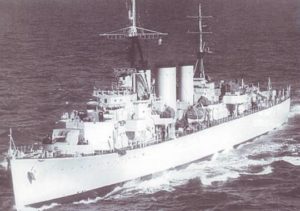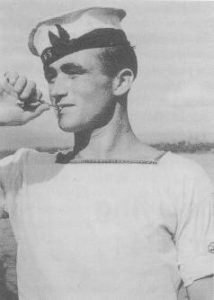- Author
- Dowle, Ron
- Subjects
- Biographies and personal histories, Ship histories and stories, WWII operations
- Tags
-
- RAN Ships
- None noted.
- Publication
- September 2005 edition of the Naval Historical Review (all rights reserved)
After surviving the sinking of the aircraft carrier HMS Glorious in the Norwegian campaign in 1940, and a long and painful recovery from acute exposure, the author was posted to a new ship, building at John Brown’s yard in Glasgow in late 1943, and eventually sailed Down Under for a final showdown against Japan.

HMS Ariadne (named after a Greek goddess) was a fast minelaying cruiser of 2,400 tons, with twin screws and capable of speeds in excess of 45 knots, the fastest ship ever built in a British yard. After local courses at the gunnery school (learning to use the new Oerlikon AA weapon) and aircraft recognition school (to study American and Japanese aircraft), we had a rough idea where we were all headed. Typical of Navy logic, having been specially trained, I was given the job of chief quartermaster.
Following initial trials of guns and engines, and still in one piece, we returned to port and where the ship was officially handed over by the dockyard staff. On leaving Glasgow we carried out speed trials over the measured mile. Our first and only run was calculated at about 48 knots (57 mph). The fastest ships to date had been destroyers of between 32-35 knots. The ship was built for speed as a minelayer; entering enemy territory and laying mines at night. This did not give much chance for travelling long distances. The mining deck ran from underneath the bridge right to the stern, and contained four tracks of rail lines. Each mine on its own little carriage, 250 on each track – 1000 tons of high explosive. Having the latest in submarine detection devices we were valuable as an escort, and had a few trips escorting incoming convoys.
However, our first mission was as postman, and we embarked hundreds of sacks of mail. We were to play Santa Claus for all forces in the Middle East. We were very welcome everywhere we went as we carried the Royal Mail flag at the masthead, visiting Gibraltar, Malta, Tobruk, Alexandria, Algiers, Rome and Naples – everywhere that troops were stationed. We steamed 10,000 miles in that time and were back in England within 10 days.

(Author – Time-Life Magazine)
Early in 1944 we were ordered to London, to embark a load of mines. I think that they became the longest travelled mines ever made. On putting to sea, our sealed orders contained instructions to proceed to Norfolk, Virginia, USA, then New York, where the new type of mines onboard would be examined by the US experts. We had orders to maintain sufficient speed en route to avoid submarine contact (a ship travelling at over 30 knots is almost impossible to hit). For the first 10 hours or so we kept up a constant speed slightly over 40 knots, but as the seas worsened, we started to take a real pounding. The weight of water coming over the bows had smashed our 4″ mounting on the forecastle, smashed two ship’s boats amidships, four steel deck pillars well-and-truly bent and the flexible deck joints showing a lot of movement. The Captain was compelled to cut our speed to just over 30 knots.
The damage sustained required us to enter Bermuda, a British outpost, where a few minor repairs were carried out in the naval dockyard, then on to Norfolk. The New York visit was cancelled because of the time spent in Bermuda. Soon we were on our way again, to Los Angeles via the Panama Canal. Next port was San Francisco and under the famous Golden Gate Bridge. Most of us were taken on trips around the city and also the film city of Hollywood. After a week here, we were then on our way to Honolulu, 2,228 miles by sea. On arrival we entered drydock, and all machinery was shut down; the only thing we were allowed to do onboard was sleep! It was no hardship to be told to take our meals in the American sailors’ canteen. What a vast change to our diet – real vegetables (no powdered eggs or potatoes), fresh meat and real butter. Most of the crew, I think, would have put on weight; we had not seen food like it since the war began.




